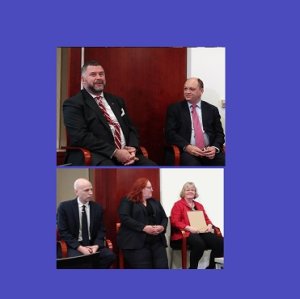
Cindy Wagner
Submitted by Cindy Wagner on

Panelists Peter Singer, Clinton Watts, Ben Roberts, Victoria Samson, Deborah Peacock
The U.S. Government Accountability Office’s newly formed (2018) Center for Strategic Foresight held its inaugural conference September 10, 2019, focusing on the policy implications arising from two major trends: increased international activity in space and the weaponization of misinformation, particularly with the use of social media.
Deep Space
Center director Stephen Sanford served as moderator for the day’s discussions, beginning with the panel on space policy. He noted that more countries now have moon missions and that India, for instance, has demonstrated an ability to shoot down a low-Earth-orbiting satellite.
Deborah Peacock, president and CEO of Peacock Law, added that India’s and Israel’s lunar landers both crashed on the moon this year and that China has landed twice on the moon since 2013. While the general public seems unaware of these missions, it’s getting to be in the news more, she said. [Ed. note: See “For NASA contractors, lunar landing failures by Israel and India hit close to home,” Washington Post (September 15).]
Victoria Samson, Washington office director of Secure World Foundation, pointed out that more than 80 countries now have space assets and two dozen have launch capability. These are largely commercial enterprises rather than controlled by nation-states, so the key question is how nation-states bring commercial actors into policy discussions. Space has always been militarized, she said, but it now might become weaponized with “counterspace capabilities.”
Ben Roberts, vice president of government affairs for Moon Express, said the U.S. government will largely turn to the commercial sector to do the science and services for space development, such as robotics and lunar lander programs. Commercial programs are trying to become less dependent on government subsidies, and about 100 companies worldwide are set to launch constellations of smaller satellites, he said.
While the Federal Aviation Administration attempts to sort out regulation of these coming constellations, with perhaps thousands of objects launched at once, tracking the objects themselves will become a challenge, Samson observed. The problem of interacting with space debris is increasing, she said, and will become more dangerous as more humans go into space.
Such risks become more sinister when the “interactions” are intentional. As Samson noted, both the United States and Russia are developing their counterspace capabilities, and India performed an anti-satellite test in March. As with agreements regarding armed conflict, agreements regarding weaponization of space will only be as good as they are implemented, she said. “If relations are bad on the ground, they’re going to be bad in orbit.”
Deep Fakes
The second featured panel discussion focused on the weaponization of information and social media. The Internet began as a communications network, and then came the influences of commerce, politicking, and wars among various tribes, said Peter Singer, strategist and senior fellow of New America. Social media has “become a new mode of conflict itself,” he said, and efforts to drive ideas have real-world effects. The fact that the truth can be buried under a sea of lies, and that “virality trumps veracity,” is what gives deep fake its power, he said.
Clinton Watts, distinguished research fellow of the Foreign Policy Research Institute, defined “deep fake” as the insertion of misinformation or disinformation into inauthentic identities, noting that Russians have figured out both the technological hacking and the social engineering and manipulation involved. It works because deep fake plays to your biases. “Social media is a lethal weapon,” he said. “It’s a nuclear bomb in the information space.” Deep fakery weapons employed by China, for instance, enable censorship, coersion, and control of the network, creating a system “beyond what Orwell imagined,” Watts said.
The weapons of deep fake are now also in the hands of ordinary citizens, Singer noted, as disinformation campaigns have a low barrier of entry. Singer cited the Russia-like attacks that fans of Lady Gaga used against the film Venom, which was released the same day as A Star Is Born. He described it as an “astroturf movement”—the same as a grassroots movement, but fake. [Ed. note: See “Lady Gaga, ‘Venom’ and When Fandom Is Weaponized,” Hollywood Reporter (October 3, 2018).]
Fighting deep fake in the future should begin with governments agreeing not to use it, Watts said. There should be a system of verification, perhaps powered by blockchain, and “nutrition labeling” for information to help people make better decisions about social media.
Singer said cybersecurity is like public health, in that you’ll always have the problem but you learn how to manage risks. The First Amendment does not allow us to ban social media, he said, but we could invoke “the Blade Runner rule,” the right to know if something is fake, like the satirical news site The Onion. When 60% of people can’t tell the difference between a news story and an ad, you need to address both the technology problems and the social issues and risks. Treat the problem like a public health issue, he said.
Singer concluded that the deep fake problem is manageable, citing Estonia’s success in dealing with the threats while preserving its democracy. [Ed. note: See “Estonia is winning the cyber war against election meddling,” Quartz (March 28, 2019).] It tracks back to what kids are taught and to leaders who own up to the problem, he said.
Center for Strategic Foresight Fellows
The September 10 conference also served to introduce two of the Center’s 2019 Fellows: Brian Masterson, senior behavioral health medical director for UnitedHealth Group, and Octavio Hinojosa-Mier, executive director, National Hispanic Corporate Council. Other fellows are:
- Rosemarie Forsythe, retired Exxon Mobil Corporation executive
- Andy Hines, head of graduate studies in foresight and assistant professor and program coordinator of the graduate program in foresight at the University of Houston
- Catarina “Cat” Tully, co-founder and director of the School of International Futures
- Kristel Van der Elst, co-founder and CEO of The Global Foresight Group
- Jens Wandel, special adviser to the secretary-general on reforms at the United Nations
- Amy Webb, quantitative futurist and professor at New York University’s Stern School of Business
- Angela Wilkinson, senior director of the World Energy Council.
For further information, see “Deep Space & Deep Fakes: New ‘Center for Strategic Foresight’ Launched” (GAO press release, September 10, 2019).
Appendix
Agenda, “From Deep Fakes to Deep Space: Policy Challenges for the Future,” September 10, 2019, Washington, D.C.
Welcome and Opening Remarks
Stephen Sanford (moderator), director, GAO Center for Strategic Foresight
Gene L. Dodaro, comptroller general of the United States
Panel on Space Policy
Deborah Peacock, president and CEO, Peacock Law
Victoria Samson, Washington office director, Secure World Foundation
Ben Roberts, vice president, government affairs, Moon Express
2019 Center Fellows Roundtable
Brian Masterson, senior behavioral health medical director, UnitedHealth Group
Octavio Hinojosa-Mier, executive director, National Hispanic Corporate Council
Panel on Deep Fakes
Peter Singer, strategist and senior fellow, New America
Clinton Watts, distinguished research fellow, Foreign Policy Research Institute
Keynote: The Future of Innovation in a World of Global Competition
Michael Crow, president, Arizona State University
The Role of Foresight in Government
James-Christian B. Blockwood, managing director, U.S. GAO Strategic Planning and External Liaison Office
About the Author
Cindy Wagner is consulting editor of AAI Foresight Inc. and editor of Foresight Signals. She may be contacted at CynthiaGWagner@gmail.com.
